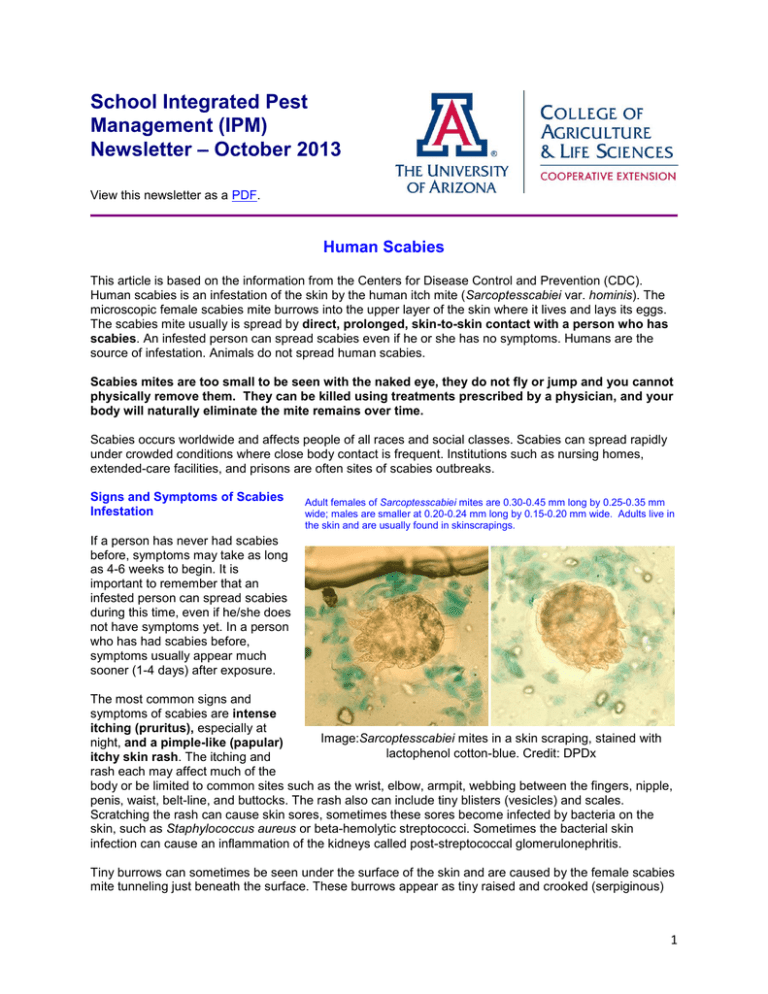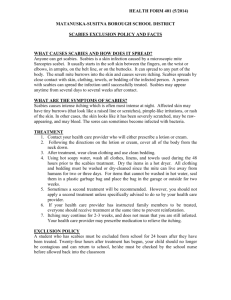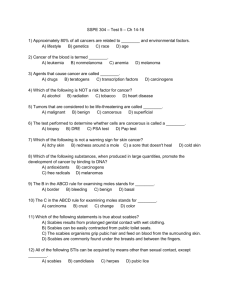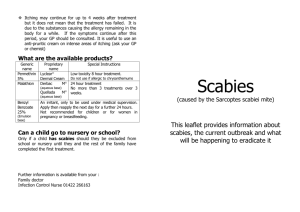School Integrated Pest Management (IPM) – October 2013
advertisement

School Integrated Pest Management (IPM) Newsletter – October 2013 View this newsletter as a PDF. Human Scabies This article is based on the information from the Centers for Disease Control and Prevention (CDC). Human scabies is an infestation of the skin by the human itch mite (Sarcoptesscabiei var. hominis). The microscopic female scabies mite burrows into the upper layer of the skin where it lives and lays its eggs. The scabies mite usually is spread by direct, prolonged, skin-to-skin contact with a person who has scabies. An infested person can spread scabies even if he or she has no symptoms. Humans are the source of infestation. Animals do not spread human scabies. Scabies mites are too small to be seen with the naked eye, they do not fly or jump and you cannot physically remove them. They can be killed using treatments prescribed by a physician, and your body will naturally eliminate the mite remains over time. Scabies occurs worldwide and affects people of all races and social classes. Scabies can spread rapidly under crowded conditions where close body contact is frequent. Institutions such as nursing homes, extended-care facilities, and prisons are often sites of scabies outbreaks. Signs and Symptoms of Scabies Infestation Adult females of Sarcoptesscabiei mites are 0.30-0.45 mm long by 0.25-0.35 mm wide; males are smaller at 0.20-0.24 mm long by 0.15-0.20 mm wide. Adults live in the skin and are usually found in skinscrapings. If a person has never had scabies before, symptoms may take as long as 4-6 weeks to begin. It is important to remember that an infested person can spread scabies during this time, even if he/she does not have symptoms yet. In a person who has had scabies before, symptoms usually appear much sooner (1-4 days) after exposure. The most common signs and symptoms of scabies are intense itching (pruritus), especially at Image:Sarcoptesscabiei mites in a skin scraping, stained with night, and a pimple-like (papular) lactophenol cotton-blue. Credit: DPDx itchy skin rash. The itching and rash each may affect much of the body or be limited to common sites such as the wrist, elbow, armpit, webbing between the fingers, nipple, penis, waist, belt-line, and buttocks. The rash also can include tiny blisters (vesicles) and scales. Scratching the rash can cause skin sores, sometimes these sores become infected by bacteria on the skin, such as Staphylococcus aureus or beta-hemolytic streptococci. Sometimes the bacterial skin infection can cause an inflammation of the kidneys called post-streptococcal glomerulonephritis. Tiny burrows can sometimes be seen under the surface of the skin and are caused by the female scabies mite tunneling just beneath the surface. These burrows appear as tiny raised and crooked (serpiginous) 1 grayish-white or skin-colored lines on the skin surface. Because mites are often few in number (only 1015 mites per person), these burrows may be difficult to find. They are found most often in the webbing between the fingers, in the skin folds on the wrist, elbow, or knee, and on the penis, breast, or shoulder blades. The head, face, neck, palms, and soles are often are affected in infants and very young children, but not usually in older children and adults. Crusted (also called Norwegian) scabies is a severe form of scabies that can occur in some persons who are immunocompromised (have a weak immune system), elderly, disabled, or debilitated. Persons with crusted scabies have thick crusts of skin that contain large numbers of scabies mites and eggs. These persons are very contagious to other persons and can spread the infestation easily both by direct skin-to-skin contact and by contamination of items such as their clothing, bedding, and furniture. Persons with crusted scabies may not show the usually signs and symptoms of scabies such as the characteristic rash or itching (pruritus). They should receive quick and aggressive medical treatment for their infestation to prevent outbreaks of scabies. Diagnosis Diagnosis of a scabies infestation usually is made based upon the customary appearance and distribution of the rash and the presence of burrows. Whenever possible, the diagnosis of scabies should be confirmed by identifying the mite or mite eggs or fecal matter (scybala). A medical professional can do this. Generally physicians obtain a skin scraping to examine under a microscope for mites, eggs, or mite fecal matter (scybala). However, a person can still be infested even if mites, eggs, or fecal matter cannot be found; fewer than 10-15 mites may be present on an infested person who is otherwise healthy. However, persons with crusted scabies can be infested with thousands of mites and should be considered highly contagious. Prevention and Control When a person is infested with scabies mites the first time, symptoms may not appear for up to two months after being infested. However, an infested person can transmit scabies, even if they do not have symptoms. Scabies is generally spread by direct, prolonged skin-to-skin contact with an infested person. However, a person with crusted (Norwegian) scabies can spread the infestation by brief skin-to-skin contact or by exposure to bedding, clothing, or even furniture that he/she has used. Scabies is prevented by avoiding direct skin-to-skin contact with an infested person or with items such as clothing or bedding used by an infested person. Scabies treatment is normally recommended for members of the same household, particularly for those who have had prolonged skin-to-skin contact. All household members and other potentially exposed persons should be considered for treatment at the same time as the infested person to prevent possible re-exposure and re-infestation. Children and adults usually can return to child care facilities, schools, or work the day after treatment. Bedding and clothing worn or used next to the skin anytime during the 3 days before treatment should be machine washed and dried using the hot water and hot dryer cycles or be dry-cleaned. Items that cannot be dry-cleaned or laundered can be disinfested by storing in a closed plastic bag for several days to a week. On a person, scabies mites can live for as long as 1-2 months. Off a person, scabies mites usually do not survive more than 48-72 hours. Scabies mites will die if exposed to a temperature of 50°C (122°F) for 10 minutes. Persons with crusted scabies and their close contacts, including household members, should be checked regularly and infected persons treated aggressively to avoid chronic infections and spread of the condition. Institutional outbreaks can be difficult to control and require a rapid, aggressive, and sustained response. Rooms used by a patient with crusted scabies should be thoroughly cleaned and vacuumed after use. Environmental disinfestation using pesticide sprays or fogs generally is unnecessary as mites cannot remain viable (and therefore are not infectious) for very long in the living environment. 2 Treatment Products used to treat scabies are called scabicides because they kill scabies mites; some also kill mite eggs. Scabicides used to treat human scabies are available only with a doctor’s prescription. No “over-the-counter” (non-prescription) products are approved to treat scabies. The instructions contained in the box or printed on the label always should be followed carefully. Always contact a doctor or pharmacist if you are unsure how to use a particular medicine. The following medications for the treatment of scabies are available only by prescription: 1. Permethrin cream 5% Permethrin is approved by the US Food and Drug Administration (FDA) for the treatment of scabies in persons who are at least 2 months of age. Permethrin is a synthetic pyrethroid similar to naturally occurring pyrethrins which are extracts from the chrysanthemum flower. It is effective when used as directed. Permethrin kills the scabies mite and eggs, and is the drug of choice for the treatment of scabies. Two (or more) applications, each about a week apart, may be necessary to eliminate all mites, particularly when treating crusted (Norwegian) scabies. 2. Crotamiton lotion 10% and Crotamiton cream 10% Crotamiton is approved by the US Food and Drug Administration (FDA) for the treatment of scabies in adults. Crotamiton is not FDA-approved for use in children. Frequent treatment failure has been reported with crotamiton. 3. Lindane lotion 1% is not recommended as a first-line therapy. Lindane is not recommended as a first-time therapy, although FDA-approved for the treatment of scabies. It should be restricted to patients who have failed treatment with or cannot tolerate FDA-approved topical medications that pose less risk. Lindane should not be used to treat premature infants, infants, children, the elderly, women who are pregnant or breast-feeding, persons with a seizure disorder, persons who have irritated skin, and persons who weigh less than 110 pounds. 4. Ivermectin Ivermectin is not FDA-approved for treatment of scabies. It should be restricted to patients who have failed treatment with or cannot tolerate FDA-approved topical medications that pose less risk. It should not be used to treat children and pregnant women. Scabicide lotion or cream should be applied to all areas of the body from the neck down to the feet and toes. In addition, when treating infants and young children, scabicide lotion or cream also should be applied to their entire head and neck because scabies can affect their face, scalp, and neck, as well as the rest of their body. The lotion or cream should be applied to a clean body and left on for the recommended time before washing it off. Clean clothing should be worn after treatment. Because the symptoms of scabies are due to a hypersensitivity reaction (allergy) to mites and their feces (scybala), itching still may continue for several weeks after treatment even if all the mites and eggs are killed. If itching persists more than 2 to 4 weeks after treatment or if new burrows or pimple-like rash lesions continue to appear, retreatment may be necessary. Skin sores that become infected should be treated with an appropriate antibiotic prescribed by a doctor. Use of insecticide sprays and bug bombs are not helpful and are not recommended. It is not necessary to treat school busses, classrooms, or any part of the school facility with pesticides if a student has tested positive for scabies. Fumigation or sterilization of school areas is unnecessary. Scabies is very unlikely to be spread by water in a swimming pool or shower. Except for a person with crusted scabies, although uncommon, scabies can be spread by sharing a towel or item of clothing that has been used by a person with scabies. 3 Scabies mites do not survive more than 2-3 days away from human skin. Items used by a person with scabies can be decontaminated by machine-washing in hot water and drying using the hot cycle or by dry-cleaning. Items and articles that cannot be washed or dry-cleaned can be decontaminated by removing from any body contact for at least 72 hours. Because persons with crusted scabies are considered very infectious, careful vacuuming of furniture and carpets in rooms used by these persons is recommended. For more information regarding human scabies: http://www.cdc.gov/parasites/scabies/index.html http://www.cdc.gov/parasites/scabies/health_professionals/meds.html http://www.cdc.gov/parasites/scabies/health_professionals/institutions.html Beware Fire Ant Stings This article is in collaboration with Janet Hurley, Texas A&M AgriLife Extension Service Program Specialist. People vary greatly in their sensitivity to fire ant stings. Some may experience very mild discomfort, while others may be hypersensitive to venom or may have medical conditions (e.g., heart condition, diabetes) that can result in serious medical problems or even death from a single sting. Individuals with a history of severe allergic reactions to insect bites or stings should consider carrying an epinephrine auto injector (EpiPen) and should wear a medical identification bracelet or necklace stating their allergy. Individuals should take the following steps if they are stung or bitten by fire ants: 1. Remove the stinging ants. The best method is to rub off ants briskly by hand or using a cloth, as they will attach to the skin with their jaws. 2. Over-the-counter Antihistamines products may help for minor stinging incidents. Follow directions on packaging. Drowsiness may occur. 3. Seek an emergency medical facility immediately if a sting causes severe chest pain, nausea, severe sweating, loss of breath, serious swelling, or slurred speech. Anaphylactic shock can lead to death. Avoiding Fire Ant Stings The best way to avoid medical emergencies associated with fire ants is to prevent being stung. Here are some tips to learn to recognize threatening situations: Look for fire ant mounds. Take care not to stand on or near them. Teach children about fire ant hazards. Alert visitors to your landscape that fire ant mounds are present. 4 Wear protective clothing when outdoor activities taking place near fire ant nests. Wear boots or tuck pant legs into socks. Control ants where they occur in areas used frequently by people and pets. Use an EPAregistered bait or other product that is labeled for fire ants. Use insect repellents on clothing or footwear. Use quick defensive reaction. Remove the ants that climb up on your body as quickly as possible. Do not disturb ant nests. Watch for foraging ants (ants looking for food). Edges of bodies of water, trash cans and areas with spilled food or sugary drinks become areas where large numbers of foraging workers congregate. Sometimes fire ants invade indoors. This is particularly common when conditions outdoors become very hot and dry or when flooding occurs in the immediate landscape. For more information about fire ants and other stinging pest first aid, please visit the CDC website at http://www.cdc.gov/niosh/topics/insects/#overview For more information about fire ant stings and how to treat them, read Fire Ant Stings on eXtension. To learn more about treating anaphylactic shock and first aid in an emergency situation click here. To learn more about fire ant lifecycles and biology clickhere. To learn more about control methods of fire ant click here. October is Children’s Health Month! Even though school has just begun, it’s never too early to start planning for a school garden! If you have ever thought about starting a school-based garden, this edition of EPA’s Healthy School News will help! Inside you will find resources and tips, awards, learning, and funding opportunities for healthy school environments. Please print for your teacher’s lounge and help distribute to teachers, facility staff, and administration in your school and district. Here’s to the start of a great school year! You can also look for archived editions of the newsletter on Region 10 Healthy Schools website. Toolbox for Education Grant Program from Lowe’s (for school improvement projects at K-12 public schools) Sponsor: The Lowe’s Charitable and Educational Foundation The Lowe’s Foundation is accepting applications for its Toolbox for Education Grant Program. The purpose of this program is to support school improvement projects at K-12 public schools in the United States. For the 2013-14 school year, the foundation will give priority to basic necessities, with a preference for funding requests that have a permanent impact, such as facility enhancement (both indoor and outdoor) as well as landscaping/cleanup projects. Projects that encourage parent involvement and help build stronger community spirit are encouraged. Grants ranging between $2,000 and $5,000 will be awarded to selected applicants. Any public K-12 school or nonprofit parent group associated with a public K-12 school is eligible to apply. 5 Deadline: October 15, 2013 Please contact the Lowe’s Charitable and Educational Foundation for more information and to apply for this funding: http://www.toolboxforeducation.com/index.html Sensible Steps to Healthier School Environments Webinar Series Join EPA for their new webinar series based on the Sensible Steps Brochure (PDF) (26pp, 1.75MB) and the State School Environmental Health Guidelines. The webinars share low- and no-cost actions that schools can take to create healthier environments for students and staff. Each webinar features school district staff from across the country presenting real-life examples of successes. The target audience includes facility maintenance staff, school nurses, administrators, teachers, and other school personnel and stakeholders. Upcoming webinars: October 22, 3-4 p.m. Eastern: Sensible Steps for Energy Efficiency in Schools with ENERGY STAR November 19, 3-4 p.m. Eastern: Sensible Steps for Mold and Moisture Control In Schools December 17, 3-4 p.m. Eastern: Renovate Right: EPA’s Renovation, Repair and Painting (RRP) Program at Schools Read more about Sensible Steps to Healthier School Environments Webinar Series, visit: http://www.epa.gov/schools/webinars.html Upcoming Webinars and Events Attend Free Sessionsof the Green Strides Webinar Series The Green Strides Webinar Series provides school communities the tools to reduce their schools’ environmental impact and costs; improve health and wellness; and teach effective environmental literacy, including STEM, green careers, and civic engagement. Find more sessions for educators, facilities managers, and advocates weekly, click here. October 16, 2013, 4-5 p.m. Eastern / 1-2 p.m. Arizona: What Can We Learn from Schoolyard Trees? (USFS/Smithsonian) October 22, 2013, 3-4 p.m. Eastern / 12-1 p.m. Arizona: Sensible Steps for Energy Efficiency in Schools with ENERGY STAR Sensible Steps to Healthier School Environments Webinar Series October 23, 2013, 7:30-9 p.m. Eastern / 4:30-6 p.m. Arizona: Teaching and Communicating About Climate Change (USFS) November 6, 2013, 2-3 p.m. Eastern / 12-1 p.m. Arizona: Don’t Mess with Mercury (CDC/ATSDR) November 6, 2013, 4-5 p.m. Eastern / 2-3 p.m. Arizona: Designing Nature Play and Learning Schoolyards (NWF) 6 The 2013 Don't Bug Me Webinar Series: brought to you by eXtension and its participating Cooperative Extension Institutions. The series is coordinated by the Imported Fire Ant eXtension Community of Practice. See http://www.extension.org/pages/66408/dont-bug-me-webinar-series-2013 November 6, 2 p.m. Eastern / 12 p.m. Arizona: Keep Ants Off the Thanksgiving Table October 25, 2013, Friday, 9-12p.m.: Tree Irrigation Study Field Day. 37860 W. Smith-Enke Rd. Maricopa, AZ 85138 You are invited to join us at the Maricopa Agricultural Center of the University of Arizona in Maricopa, AZ to see results of a long-term Tree Irrigation Study. Nine species of landscape trees have been irrigated with different treatments since 2008. You will have an opportunity to learn about the experiment and observe how the trees responded to the treatments. Participation is FREE, lunch will be provided. Space is limited and registration is required. Please register here: https://cals.arizona.edu/spls/deserthort/field_day_registration November 13, 2013, Wednesday, 7:30-12 p.m.: Integrated Pest Management in a Child’s World. Flagstaff Unified School District – Administrative Center, 3285 E. Sparrow Ave, Flagstaff, AZ 96004. Free Registration. This workshop for school personnel will provide information on: Integrated Pest Management (IPM) philosophy and the best way to manage pests, including bees and wasps, weed control in landscapes and turf, rodents and bats. Participates will be awarded four Continuing Education Units for Office of Pest Management (general category).To register for the class call Shaku Nair at 520840-9429 and other inquiries can be sent to Shaku Nair nairs@email.arizona.edu, Assistant in Extension for Community IPM, University of Arizona. January 6-10, 2014. A one-week course Desert Turf School. The University of Arizona Maricopa County Cooperative Extension office, 4341 E. Broadway Rd. Phoenix, AZ 85040. The 2014 Desert Turf School registration is now available online. Golf course superintendents getting introduced to the desert, assistants and golf course staff wanting more in-depth knowledge of turf management, sports turf managers, schools and municipal facilities managers, commercial landscapers responsible for turf maintenance are all encouraged to sign up now. (Do it before the craziness of the overseeding season) The Desert Turf School is a week-long offering about desert turf species and their unique management practices, desert soils, fertility, and nutrition, salinity principles, irrigation audits and analyses, "smart" controllers, heat and drought stress, disease, insect, nematode, and weed management. Register now to attend the 2014 Desert Turf School at the UA Cooperative Extension in Phoenix during January 6-10, 2014. Online registration is available but a discounted mail-in fee is also an option. For details, go to: http://turf.arizona.edu/index.htm For more information about the EPA Schools program, visit: http://www.epa.gov/schools/ For more information about the Community IPM, visit: http://www.extension.org/pages/23359/urban-integrated-pest-management-community-page 7 For more information about School IPM in Arizona, visit: http://cals.arizona.edu/apmc/westernschoolIPM.html Shujuan (Lucy) Li, Newsletter Editor and Assistant in Extension.Email: lisj@cals.arizona.edu DawnH. Gouge, Public Health IPM Expert. Email:dhgouge@cals.arizona.edu Shaku Nair, Assistant in Extension. Email:nairs@email.arizona.edu Al Fournier, IPM Assessment.Email: fournier@cals.arizona.edu Ursula Schuch, Landscape Horticulture.Email: ukschuch@ag.arizona.edu Paul Baker, Urban Entomologist.Email: pbaker@ag.arizona.edu Kai Umeda, Extension Agent, Turf.Email: kumeda@cals.arizona.edu Dave Kopec, Turf Specialist.Email: dkopec@ag.arizona.edu 8 Acknowledgements This material is based upon work that is supported in part by the National Institute of Food and Agriculture, U.S. Department of Agriculture (USDA NIFA). Any opinions, findings, conclusions, or recommendations expressed in this publication are those of the authors and do not necessarily reflect the view of the U.S. Department of Agriculture. Additional support is provided by the U.S. Environmental Protection Agency (EPA) and the University of Arizona – Arizona Pest Management Center (APMC).





